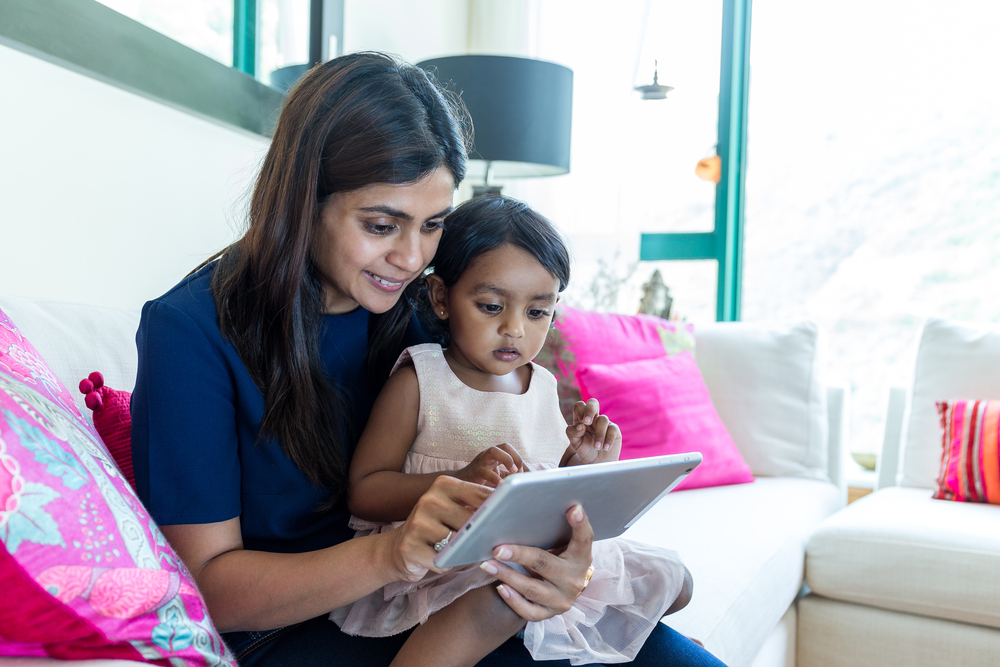
Ever been in a home visit with a parent who is simultaneously using his/her phone while discussing the child with you? There are lots of ways that phones and screen time show up during visits. For instance, parents hand their child a phone to keep him quiet or distract other children in the home. Parents may pull out their phones to take down notes about interventions or the next appointment. They show us videos and pictures of exciting progress in milestones, or to ask a question about something going on with their child.
Cell phones and all other forms of screens are such a huge part of life today, including children’s lives starting as early as infancy and toddlerhood. As service coordinators and providers, we can choose to resist or ignore these changes, and feel frustrated with how they impact early intervention outcomes. OR, we can step up to the challenge of employing phones and technology as tools in our interventions and interactions with families.
AAP Screen Time Recommendations
The American Academy of Pediatrics has made a formal statement of recommendations for use of technology for children of all ages in their Media and Young Minds Policy (2016). Some specific advice for ages 0-3 includes:
- For children younger than 18 months, discourage the use of screen media other than video-chatting.
- For parents of children 18 to 24 months of age who want to introduce digital media, advise that they choose high-quality programming/apps and use them together with children, because this is how toddlers learn best. Letting children use media by themselves should be avoided.
- In children older than 2 years, limit media to 1 hour or less per day of high-quality programming. Recommend shared use between parent and child to promote enhanced learning, greater interaction, and limit setting.
- Recommend no screens during meals and for 1 hour before bedtime.
Parents often express guilt to providers over undesirable screen time issues with their child, and look to us for support. Advice from author, Lisa Guernsey, recommends that families and early childhood professionals consider the “Three C’s” when determining when and how to use various technologies: content, context and the individual child. Together with families, we can consider the following questions to begin supporting them in implementing the AAP’s recommendations, while keeping technology as a tool on our side.
- We can ask how does the content help children learn, engage, express, imagine, or explore?
- What kinds of social interactions are happening before, during, and after the use of the technology? Does it complement, and not interrupt, children’s learning experiences and natural play patterns?
- Does this technology match with this child’s needs, abilities, interests, and development stage? (Guiding Principles for Use of Technology with Early Learners, 2016)
7 Ways to Support Families and Outcomes Using Technology
Once we’ve evaluated the values of technology per each child’s situation, we can consider employing some of the following strategies for intervention and improvement.
- Parents can use video chats as a new and exciting way for children to use their language and imitation skills with a variety of people.
- Show parents how they can engage in an app or screen time activity together with their child to promote quality interactions.
- At the end of a visit, encourage parents to set a reminder alert in their phone to practice certain strategies or focus on a specific interaction with their child.
- Recommend apps that educate and support parents in understanding child development, such as: CDC’s Milestone Tracker, VROOM, and HelloJoey.
- Educate parents about how to evaluate apps/programs for developmental appropriateness.
- Coach parents in setting boundaries with screen time and managing challenging behaviors that may arise from this. Help them determine specific “screen free” routines throughout the day.
- Remind parents that no “educational” technology or program is better for their child’s development than regularly engaging in interaction, exploration, and play everyday!
Share your thoughts and experiences below by leaving a comment:
How have you seen screens and technology impacting Early Intervention visits?
Have families ever asked for advice about apps or programs to help their child? How do you or would you respond?
Please share any great technology resources that you have found in the comments too!
References
Guiding Principles for Use of Technology with Early Learners. (2016). Retrieved from https://tech.ed.gov/earlylearning/principles/.
Radesky, J., and Christakis, D. (2016). Media and young minds. Journal of the Academy of Pediatrics, 138(5), doi:10.1542/peds.2016-2591.

Rachel Todd lives in Northern Utah and has worked as a Service Coordinator for the Up to 3 Early Intervention Program since 2017. She has a Bachelor’s degree in Family, Consumer, and Human Development emphasizing in child development and worked with families in Early Head Start programs before joining EI. She is also a graduate student in the Instructional Technology & Learning Sciences program at Utah State University and loves professional development of all forms. Rachel and her husband have a one-year-old son and a spoiled fur baby and love to get outside in the mountains together every chance they get! You can reach Rachel at
rachel.todd@usu.edu



In our current climate, more families are asking about screen time during our telepractice visits together. Most are worried about the amount of time their kids are now spending with screens. I have been working hard to encourage families to engage with their children with screens, acknowledging that our lives are different now and not every family can afford new toys and books or have a big backyard to play in. One of my favorite strategies to support parent-child interactions with screens is watching family videos together and talking about them. Children love to see themselves on screen, and if there’s an older sibling or other family member who can video the child singing and dancing or playing outside (if possible), that video creates an opportunity for engagement and learning. Vocabulary targets can include family members’ names and action words. Careful physical positioning can encourage children to look up to their family members as they watch together to support joint attention. And above all, helping families to allow themselves grace as they navigate this challenging time!
I love the idea of watching family videos together! There are so many opportunities presented by that. Thank you for sharing.
Yes to encouraging families to allow themselves a little grace – I literally had this conversation with a parent today! I often work with families who really struggle with their child’s attachment to screen time (particularly when concerns regarding autism or other learning differences are involved), coupled with that parental guilt. I have found that talking them through creative alternatives to try as they figure out how to wean out screen time for their child has been helpful. Today, for example, we discussed trying recording videos of mom and child playing peekaboo together or family members singing some of her favorite songs to curate their own playlist of videos for her. We discussed that, even if the family does find there are times they need to rely on screen time to keep the child occupied for a few minutes, they may be able to use videos that focus attention on the family instead of on the animations the child often gravitates to. Of course, that the best way to enjoy those videos is together!
I love your ideas for recording videos of the family together! Thanks for adding that great tip, Carolyn!